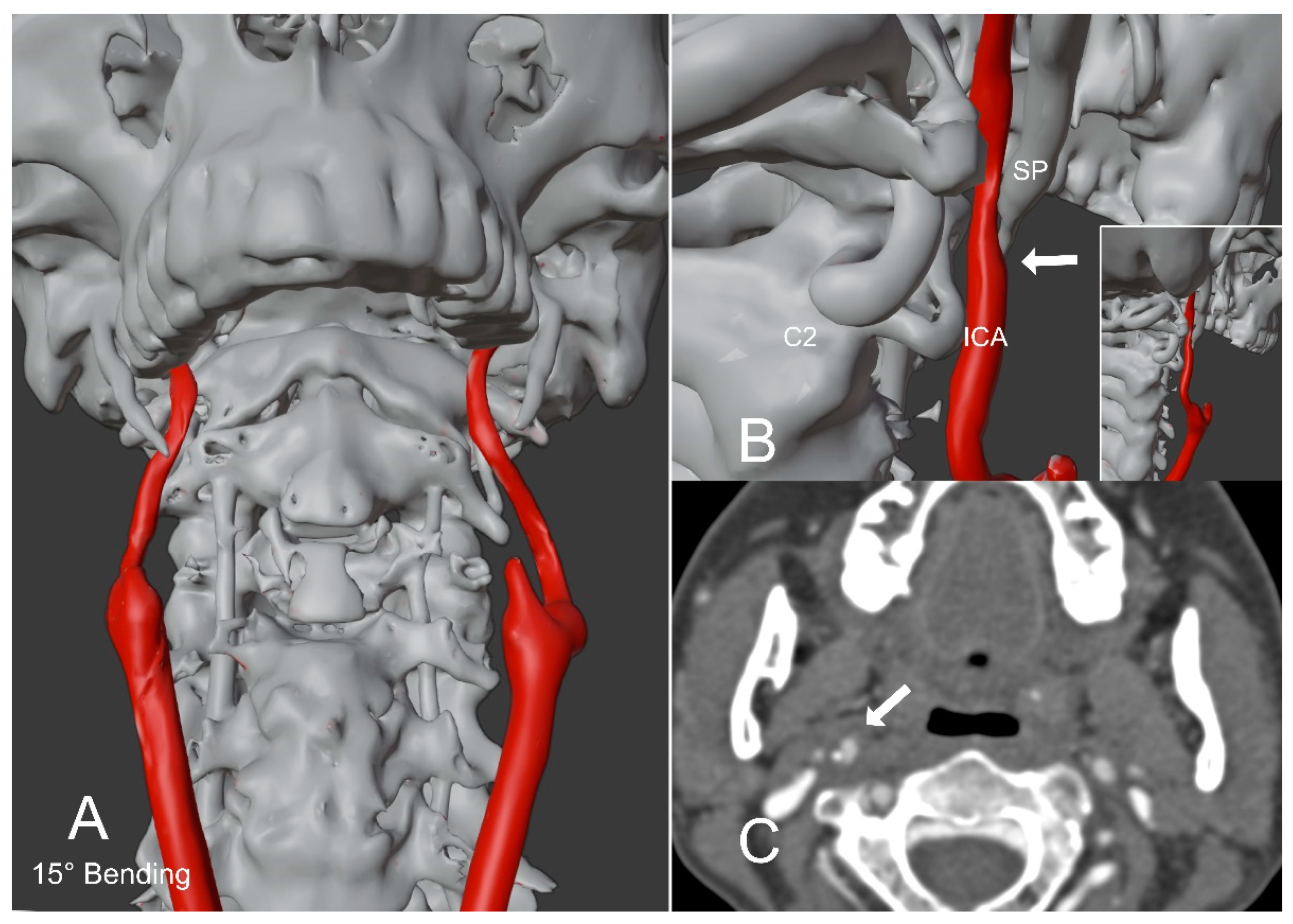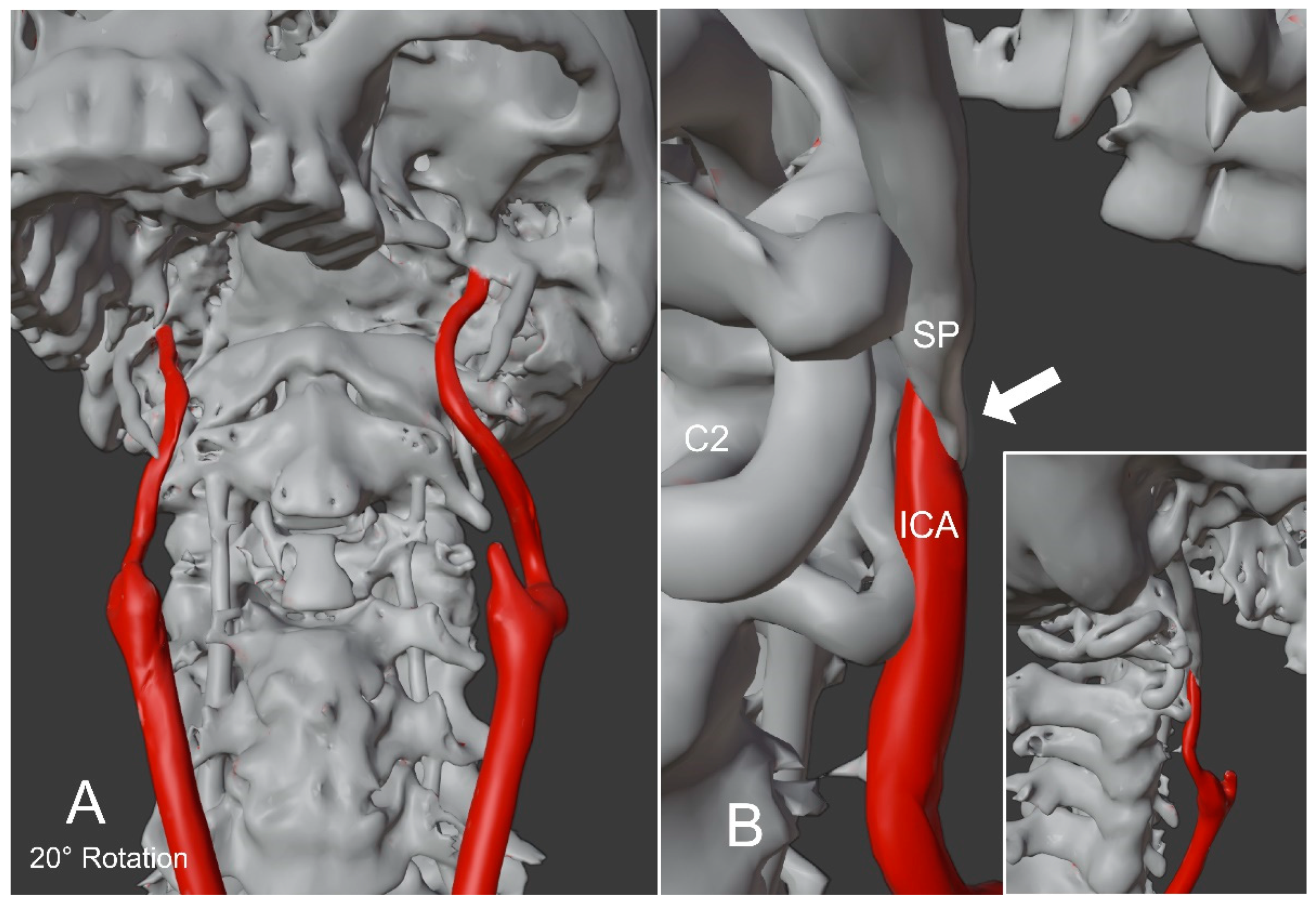Can a 3D Virtual Imaging Model Predict Eagle Syndrome?
Abstract
:1. Technical Note: Eagle Syndrome (ES) Is an Underestimated Syndrome with Broad and Often Unspecific Signs and Symptoms
Supplementary Materials
Author Contributions
Funding
Institutional Review Board Statement
Informed Consent Statement
Data Availability Statement
Conflicts of Interest
References
- Galletta, K.; Siniscalchi, E.N.; Marco, C.; Mariano, V.; Francesca, G. Eagle syndrome: A wide spectrum of clinical and neuroradiological findings from cervico-facial pain to cerebral ischemia. J. Craniofacial Surg. 2019, 30, E424–E428. [Google Scholar] [CrossRef] [PubMed]
- Eagle, W.W. The symptoms, diagnosis and treatment of the elongated styloid process. Am Surg. 1962, 28, 1–5. [Google Scholar] [PubMed]
- Tijanić, M.; Burić, N.; Burić, K. The Use of Cone Beam CT(CBCT) in Differentiation of True from Mimicking Eagle’s Syndrome. Int. J. Environ. Res. Public Health 2020, 17, 5654. [Google Scholar] [CrossRef] [PubMed]
- Brassart, N.; Deforche, M.; Goutte, A.; Wery, D. A rare vascular complication of Eagle syndrome highlight by CTA with neck flexion. Radiol. Case Rep. 2020, 15, 1408–1412. [Google Scholar] [CrossRef] [PubMed]
- Pieper, S.; Lorensen, B.; Schroeder, W.; Kikinis, R. The NA-MIC Kit: ITK, VTK, Pipelines, Grids and 3D Slicer as an Open Platform for the Medical Image Computing Community. In Proceedings of the 3rd IEEE International Symposium on Biomedical Imaging: From Nano to Macro, Arlington, VA, USA, 6–9 April 2006; Volume 1, pp. 698–701. [Google Scholar]
- Community, B.O. Blender—A 3D Modelling and Rendering Package. Stichting Blender Foundation, Amsterdam. 2018. Available online: http://www.blender.org (accessed on 29 April 2022).



Publisher’s Note: MDPI stays neutral with regard to jurisdictional claims in published maps and institutional affiliations. |
© 2022 by the authors. Licensee MDPI, Basel, Switzerland. This article is an open access article distributed under the terms and conditions of the Creative Commons Attribution (CC BY) license (https://creativecommons.org/licenses/by/4.0/).
Share and Cite
Nastro Siniscalchi, E.; Mormina, E.; Cicchiello, S.; Granata, F.; Vinci, S.L.; Galletta, K.; Catalfamo, L.; De Ponte, F.S. Can a 3D Virtual Imaging Model Predict Eagle Syndrome? Appl. Sci. 2022, 12, 4564. https://doi.org/10.3390/app12094564
Nastro Siniscalchi E, Mormina E, Cicchiello S, Granata F, Vinci SL, Galletta K, Catalfamo L, De Ponte FS. Can a 3D Virtual Imaging Model Predict Eagle Syndrome? Applied Sciences. 2022; 12(9):4564. https://doi.org/10.3390/app12094564
Chicago/Turabian StyleNastro Siniscalchi, Enrico, Enricomaria Mormina, Samuele Cicchiello, Francesca Granata, Sergio Lucio Vinci, Karol Galletta, Luciano Catalfamo, and Francesco Saverio De Ponte. 2022. "Can a 3D Virtual Imaging Model Predict Eagle Syndrome?" Applied Sciences 12, no. 9: 4564. https://doi.org/10.3390/app12094564
APA StyleNastro Siniscalchi, E., Mormina, E., Cicchiello, S., Granata, F., Vinci, S. L., Galletta, K., Catalfamo, L., & De Ponte, F. S. (2022). Can a 3D Virtual Imaging Model Predict Eagle Syndrome? Applied Sciences, 12(9), 4564. https://doi.org/10.3390/app12094564





